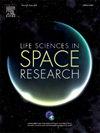Status update of NASAs assessment of the biological contamination threat of crewed mars surface missions
IF 2.8
3区 生物学
Q2 ASTRONOMY & ASTROPHYSICS
引用次数: 0
Abstract
As we prepare for a future first mission to Mars with a human crew, the United States, under the Outer Space Treaty of 1967, has an obligation to protect against harmful contamination of the red planet and to protect the Earth from the potential harmful effects of material brought from Mars. In previous years NASA has partnered with the Committee on Space Research (COSPAR), the European Space Agency (ESA), the Japanese Aerospace Exploration Agency (JAXA) and other space exploration organizations to conduct a series of workshops on identifying knowledge gaps for protecting Mars from Earth microorganisms during such a crewed mission, and for protecting Earth from a potential Martian biosphere, should it exist. The current international planetary protection consensus policy (COSPAR, 2024) only has high-level guidance for crewed missions thus continuing conversations are needed to further define specific requirements for implementing a crewed missions to Mars.
In this paper, we are surveying the biological contamination tradespace to capture and understand the scope of terrestrial microbiology present on a crewed Mars mission. This is a first step to ensure we can manage the harmful biological contamination threat to a putative Martian biosphere and that terrestrial biological contamination will be controlled. Additionally, we are working towards developing a common understanding and basis of assessment of the contamination thresholds that can be used to describe “how much is too much” from a policy point of view. Specifically, we are providing estimates of what the biological contamination will be for a 30 sol stay with two crew members on the surface of Mars.
The study is to identify the sources and estimate the scale of biological contamination a human mission might bring to the surface of Mars, and to identify where we can potentially reduce or mitigate that contamination. This work does not consider backward contamination to Earth from a crewed mission to Mars, or orbital contamination in any detail. The architecture that we studied is described in HEOMD 415 (Hoffman 2022) which details a “small footprint” mission that would consist of 4 crew members for the trip to Mars, with 2 crew staying in orbit and 2 going to the surface of Mars in a 3 × 25Ton lander configuration, as well as a variant that used a single, larger lander concept. In these concepts, crew would stay in a pressurized rover and not a fixed habitat. The crew would be on the surface for approximately 30 sols in this minimum mission. It is important to note that there is no designated NASA architecture for a crewed mission to Mars and that the one we used is already in the process of being further updated.
美国宇航局对载人火星表面任务生物污染威胁评估的最新情况
在我们为未来首次载人火星任务做准备时,根据1967年的《外层空间条约》,美国有义务保护这颗红色星球免受有害污染,并保护地球免受火星带来的物质的潜在有害影响。在过去几年中,美国宇航局与空间研究委员会(外空委员会)、欧洲航天局(欧空局)、日本宇宙航空研究开发机构(JAXA)和其他空间探索组织合作,举办了一系列讲习班,以确定在这种载人任务期间保护火星免受地球微生物侵害的知识差距,以及保护地球免受潜在的火星生物圈(如果存在的话)的侵害。目前的国际行星保护共识政策(COSPAR, 2024)仅对载人飞行任务提供了高层指导,因此需要继续进行对话,以进一步确定实施载人火星飞行任务的具体要求。在本文中,我们正在调查生物污染交易空间,以捕获和了解火星任务中存在的陆地微生物的范围。这是确保我们能够控制对假定的火星生物圈的有害生物污染威胁的第一步,也是确保地球生物污染将得到控制的第一步。此外,我们正努力建立对污染阈值的共同理解和评估基础,这些阈值可用于从政策角度描述“多少是太多”。具体来说,我们提供了两名宇航员在火星表面停留30个月的生物污染估计。这项研究的目的是确定人类任务可能给火星表面带来的生物污染的来源和规模,并确定我们可以在哪里减少或减轻这种污染。这项工作没有考虑载人火星任务对地球的向后污染,也没有考虑轨道污染的任何细节。我们研究的架构在HEOMD 415 (Hoffman 2022)中有描述,其中详细描述了一个“小足迹”任务,该任务将由4名机组人员组成,用于火星之旅,其中2名机组人员留在轨道上,2名机组人员在3 × 25吨的着陆器配置中前往火星表面,以及使用单个更大着陆器概念的变体。在这些概念中,宇航员将呆在加压漫游车里,而不是固定的栖息地。在这个最小的任务中,机组人员将在月球表面停留大约30个太阳。值得注意的是,美国宇航局没有为载人火星任务指定的结构,我们使用的结构已经在进一步更新的过程中。
本文章由计算机程序翻译,如有差异,请以英文原文为准。
求助全文
约1分钟内获得全文
求助全文
来源期刊

Life Sciences in Space Research
Agricultural and Biological Sciences-Agricultural and Biological Sciences (miscellaneous)
CiteScore
5.30
自引率
8.00%
发文量
69
期刊介绍:
Life Sciences in Space Research publishes high quality original research and review articles in areas previously covered by the Life Sciences section of COSPAR''s other society journal Advances in Space Research.
Life Sciences in Space Research features an editorial team of top scientists in the space radiation field and guarantees a fast turnaround time from submission to editorial decision.
 求助内容:
求助内容: 应助结果提醒方式:
应助结果提醒方式:


